Finite Element Analysis of Laminar Natural Convection in a Differentially Heated Porous Cavity Using the Darcy–Brinkman Model
Abstract
:1. Introduction
2. Mathematical Modeling
2.1. Problem Definition
- -
- Fluid and porous medium properties are assumed constant.
- -
- In the momentum equations, both viscous drag and inertia are considered negligible.
- -
- Thus, it is valid to use the Boussinesq approximation.
- -
- Laws based on the Darcy–Brinkman law are applicable.
2.2. Mathematical Formulation
2.2.1. Porous Domain
2.2.2. Fluid Domain
2.3. Specifications of Boundary Conditions
2.4. Numerical Method and Validation
2.4.1. Numerical Methodology
2.4.2. Mesh Characteristics
2.4.3. Convergence Criteria
2.4.4. Computational Resources
- -
- Processor: AMD Ryzen 9 3900X 12-Core, 3.80 GHz.
- -
- Memory: 64 GB RAM.
- -
- Operating system: Windows 10 Pro.
2.4.5. Validation
3. Results and Discussions
4. Conclusions
Author Contributions
Funding
Data Availability Statement
Acknowledgments
Conflicts of Interest
Nomenclature
| CP | Specific heatat constant pressure (J·kg−1·K −1) |
| Da | Darcy number (Da = κ/L2) |
| g | Gravitational field (m·s−2) |
| H | Cavity height (m) |
| k | Thermal conductivity (W·m−1·K−1) |
| L | Cavity length (m) |
| Nu | Nusselt number |
| p | Pressure (N·m−2) |
| Pr | Prandtl number |
| Ra | Rayleigh number |
| T | Temperature (K) |
| u | Velocity component along x-direction (m·s−1) |
| U | Dimensionless velocity component along x-direction |
| v | Velocity component along y-direction (m·s−1) |
| V | Dimensionless velocity component along y-direction |
| x, y | Cartesian coordinates (m) |
| X, Y | Dimensionless Cartesian coordinates |
| Greek Symbols | |
| β | Thermal expansion coefficient (K−1) |
| Porosity of the porous layer | |
| ν | Kinematic viscosity (m2·s−1) |
| θ | Dimensionless temperature |
| ρ | Density (kg·m−3) |
| κ | Permeability of porous medium (m2) |
| μ | Dynamic viscosity (Pa·s) |
| α | Thermal diffusivity (m2·s−1) |
| Subscripts | |
| eff | Effective |
| f | Fluid |
| h | Hot |
| s | Solid |
| w | Wall |
References
- Xu, J.; Wei, H.; Bao, H. Physics-informed neural networks for studying heat transfer in porous media. Int. J. Heat Mass Transf. 2023, 217, 124671. [Google Scholar] [CrossRef]
- Kaviany, M. Principles of Heat Transfer in Porous Media; Springer Science & Business Media: Berlin, Germany, 2012. [Google Scholar] [CrossRef]
- Tien, C.L.; Vafai, K. Convective and radiative heat transfer in porous media. Adv. Appl. Mech. 1989, 27, 225–281. [Google Scholar] [CrossRef]
- Vafai, K.; Tien, C.L. Boundary and inertia effects on flow and heat transfer in porous media. Int. J. Heat Mass Transf. 1981, 24, 195–203. [Google Scholar] [CrossRef]
- Mekroussi, S.; Kherris, S.; Mebarki, B.; Benchatti, A. Mixed convection in complicated cavity with non-uniform heating on both sidewalls. Int. J. Heat Technol. 2017, 35, 1023–1033. [Google Scholar] [CrossRef]
- Walker, K.L.; Homsy, G.M. Convection in a porous cavity. J. Fluid Mech. 1978, 87, 449–474. [Google Scholar] [CrossRef]
- Kumar, A.; Pramanik, S.; Mishra, M. COMSOL Multiphysics® Modeling in Darcian and Non-Darcian Porous Media. In Proceedings of the 2016 COMSOL Conference, Bangalore, India, 20–21 October 2016; pp. 20–21. [Google Scholar]
- Baytas, A.C.; Pop, I. Free convection in a square porous cavity using a thermal nonequilibrium model. Int. J. Therm. Sci. 2002, 41, 861–870. [Google Scholar] [CrossRef]
- Saidi, L.; Mekroussi, S.; Kherris, S.; Zebbar, D.; Mébarki, B. A numerical investigation of the free flow in a square porous cavity with non-uniform heating on the lower wall. Eng. Technol. Appl. Sci. Res. 2022, 12, 7982–7987. [Google Scholar] [CrossRef]
- Saeid, N.H. Natural convection in porous cavity with sinusoidal bottom wall temperature variation. Int. Commun. Heat Mass Transf. 2005, 32, 454–463. [Google Scholar] [CrossRef]
- Muyungi, W. Effects of Navier Slip and Skin Friction on Nanofluid Flow in a Porous Pipe. Ph.D. Thesis, NM-AIST, Arusha, Tanzania, 2022. [Google Scholar] [CrossRef]
- Menni, Y.; Chamkha, A.J.; Kaid, N.; Ameur, H.; Bensafi, M.; Sahel, D.; Lorenzini, G. Advances of heat transfer in porous media—A review. Spec. Top. Rev. Porous Media Int. J. 2020, 11, 1–18. [Google Scholar] [CrossRef]
- Huang, C.W.; Srikanth, V.; Kuznetsov, A.V. The evolution of turbulent micro-vortices and their effect on convection heat transfer in porous media. J. Fluid Mech. 2022, 942, A16. [Google Scholar] [CrossRef]
- Nabwey, H.A.; Armaghani, T.; Azizimehr, B.; Rashad, A.M.; Chamkha, A.J. A comprehensive review of nanofluid heat transfer in porous media. Nanomaterials 2023, 13, 937. [Google Scholar] [CrossRef] [PubMed]
- Douha, M.; Draoui, B.; Kaid, N.; Ameur, H.; Belkacem, A.; Mohamed, E.; Merabti, A.; Aissani, H. Study of laminar naturel convection in partially porous cavity in the presence of nanofluids. J. Adv. Res. Fluid Mech. Therm. Sci. 2021, 79, 91–110. [Google Scholar] [CrossRef]
- Li, B.; Xu, H.; Song, Y.J.; Zhang, H.L.; Wang, W.W.; Zhao, F.Y. Heat and moisture transports in a slot ventilated enclosure packed with discrete porous media: Mixing convection instability, oscillation and resonance. Int. J. Therm. Sci. 2023, 194, 108603. [Google Scholar] [CrossRef]
- Liu, J.; Yu, P.; Li, Y.; Wan, C.; Du, D. Numerical simulation on convective heat transfer characteristics in porous media based on the digital rock technology. Int. J. Heat Mass Transf. 2022, 196, 123323. [Google Scholar] [CrossRef]
- Lauriat, G.; Ghafir, R. Forced convective heat transfer in porous media. In Handbook of Porous Media; Dekker: New York, NY, USA, 2000; pp. 201–204. [Google Scholar] [CrossRef]
- Chu, X.; Yang, G.; Pandey, S.; Weigand, B. Direct numerical simulation of convective heat transfer in porous media. Int. J. Heat Mass Transf. 2019, 133, 11–20. [Google Scholar] [CrossRef]
- Shenoy, A.V. Non-Newtonian fluid heat transfer in porous media. Adv. Heat Transf. 1994, 24, 101–190. [Google Scholar] [CrossRef]
- Zhu, X.; Pan, D.; Gao, Y.; Guo, Y.; Guan, Y.; Ma, H. Heat transfer enhancement in a regenerative cooling channel using porous media. Chem. Eng. Process. Process Intensif. 2023, 183, 109234. [Google Scholar] [CrossRef]
- Younus, Y.M.; Raheem, H.M.; Al-Hajjar, A.M. Novel approach for modeling a full-sized air-cooled heat exchanger using porous media and iterative processes. Results Eng. 2023, 20, 101459. [Google Scholar] [CrossRef]
- Bazneshin, M.N.; Borji, M.; Gholami, R. Numerical Investigation of phase transition in different latent heat storage systems in the presence of natural convection and porous media. Case Stud. Therm. Eng. 2023, 50, 103450. [Google Scholar] [CrossRef]
- Grosan, T.; Patrulescu, F.O.; Pop, I. Natural convection in a differentially heated cavity filled with a Brinkman bidisperse porous medium. Int. J. Numer. Methods Heat Fluid Flow 2023, 33, 3309–3326. [Google Scholar] [CrossRef]
- Javed, S.; Saha, S. Estimation of comprehensive thermal performance for conjugate natural convection inside a dome-shaped porous chamber holding a solid cylinder. Results Eng. 2023, 17, 100896. [Google Scholar] [CrossRef]
- Shruti, B.; Alam, M.M.; Parkash, A.; Dhinakaran, S. Darcy number influence on natural convection around porous cylinders in an enclosure using Darcy-Brinkman-Forchheimer model: LBM study. Case Stud. Therm. Eng. 2023, 45, 102907. [Google Scholar] [CrossRef]
- Aslam, M.A.; Yao, H.; Al Mesfer, M.K.; Irshad, K.; Chuhan, I.S.; Danish, M.; Hassan, A.M.; Shahzad, H.; Eldin, S.M. Finite element modeling of dual convection in a Y shaped porous cavity containing viscus fluid. Front. Phys. 2023, 11, 1207462. [Google Scholar] [CrossRef]
- Abderrahmane, A.; Manoongam, A.; Alizadeh, A.A.; Younis, O.; Zekri, H.; Isa, S.S.P.M.; Baghaei, S.; Jamshed, W.; Guedri, K. Investigation of the free convection of nanofluid flow in a wavy porous enclosure subjected to a magnetic field using the Galerkin finite element method. J. Magn. Magn. Mater. 2023, 569, 170446. [Google Scholar] [CrossRef]
- Al-Waaly, A.A.; Tumpa, S.A.; Nag, P.; Paul, A.R.; Saha, G.; Saha, S.C. Entropy generation associated with natural convection within a triangular porous cavity containing equidistant cold domains. Front. Energy Res. 2024, 12, 1422256. [Google Scholar] [CrossRef]
- Issakhov, A.; Sabyrkulova, A.; Abylkassymova, A. Study of coupled natural convection in a two-dimensional square cavity with a partition with solid and porosity properties. Int. Commun. Heat Mass Transf. 2024, 155, 107539. [Google Scholar] [CrossRef]
- Charreh, D.; Islam, S.U.; Talib, S.; Saleem, M.; Abbas, M.A.; Ahmad, S. Numerical investigation of entropy generation and Magnetohydronamic natural convection in a porous square cavity with four embedded cylinders. Heliyon 2024, 10, 33897. [Google Scholar] [CrossRef]
- Wan, D.C.; Patnaik, B.S.V.; Wei, G.W. A new benchmark quality solution for the buoyancy-driven cavity by discrete singular convolution. Numer. Heat Transf. Part B Fundam. 2010, 40, 199–228. [Google Scholar] [CrossRef]
- de Vahl Davis, G. Natural convection of air in a square cavity: A bench mark numerical solution. Int. J. Numer. Methods Fluids 1983, 3, 249–264. [Google Scholar] [CrossRef]
- Bilgen, E.; Yedder, R.B. Natural convection in enclosure with heating and cooling by sinusoidal temperature profiles on one side. Int. J. Heat Mass Transf. 2007, 50, 139–150. [Google Scholar] [CrossRef]
- Fenni, M.; Guellal, M.; Hamimid, S. Influence of porosity properties on natural convection heat transfer in porous square cavity. Phys. Fluids 2024, 36, 056108. [Google Scholar] [CrossRef]
- Karpenko, M. Aircraft hydraulic drive energy losses and operation delay associated with the pipeline and fitting connections. Aviation 2024, 28, 1–8. [Google Scholar] [CrossRef]
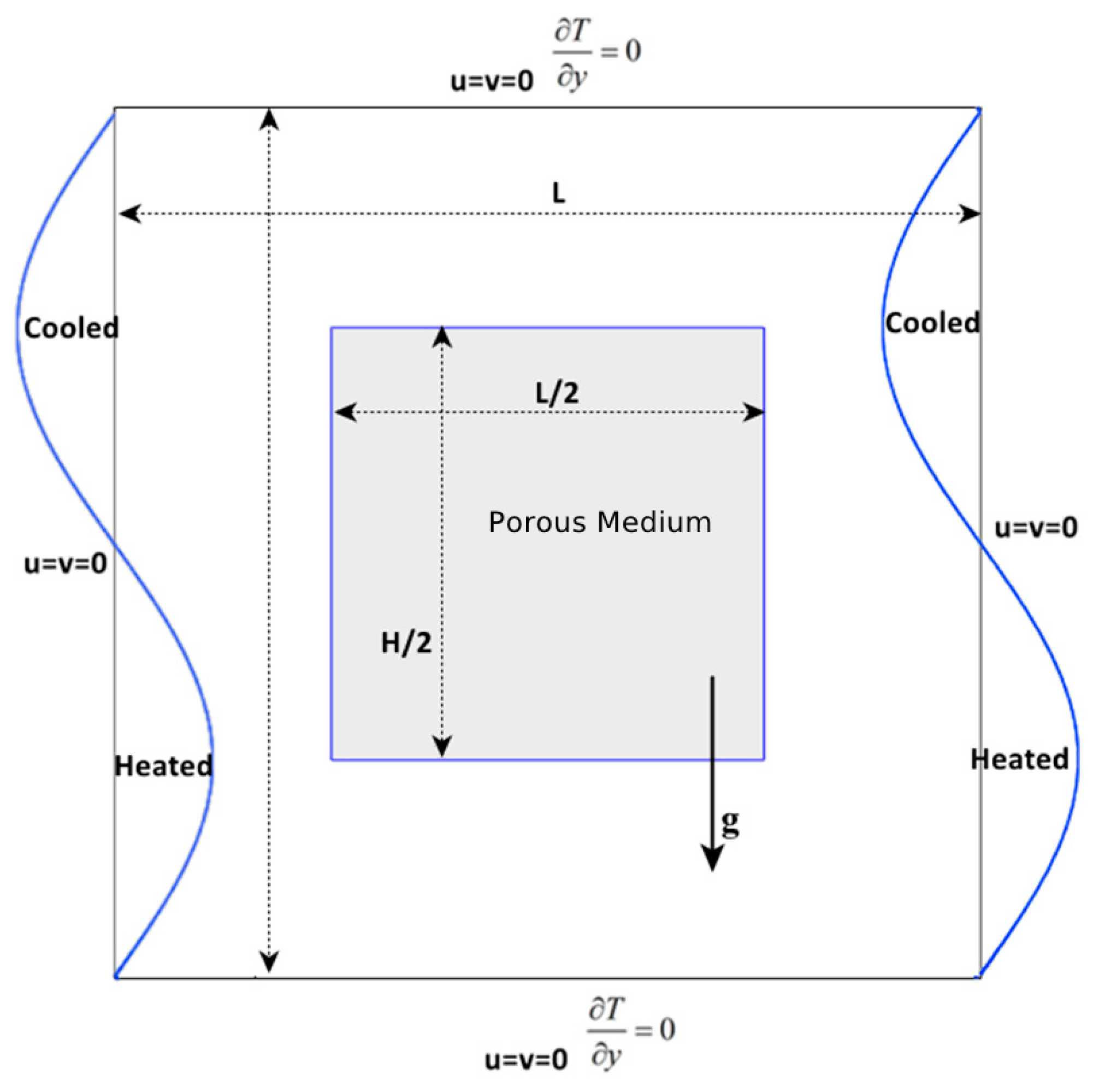
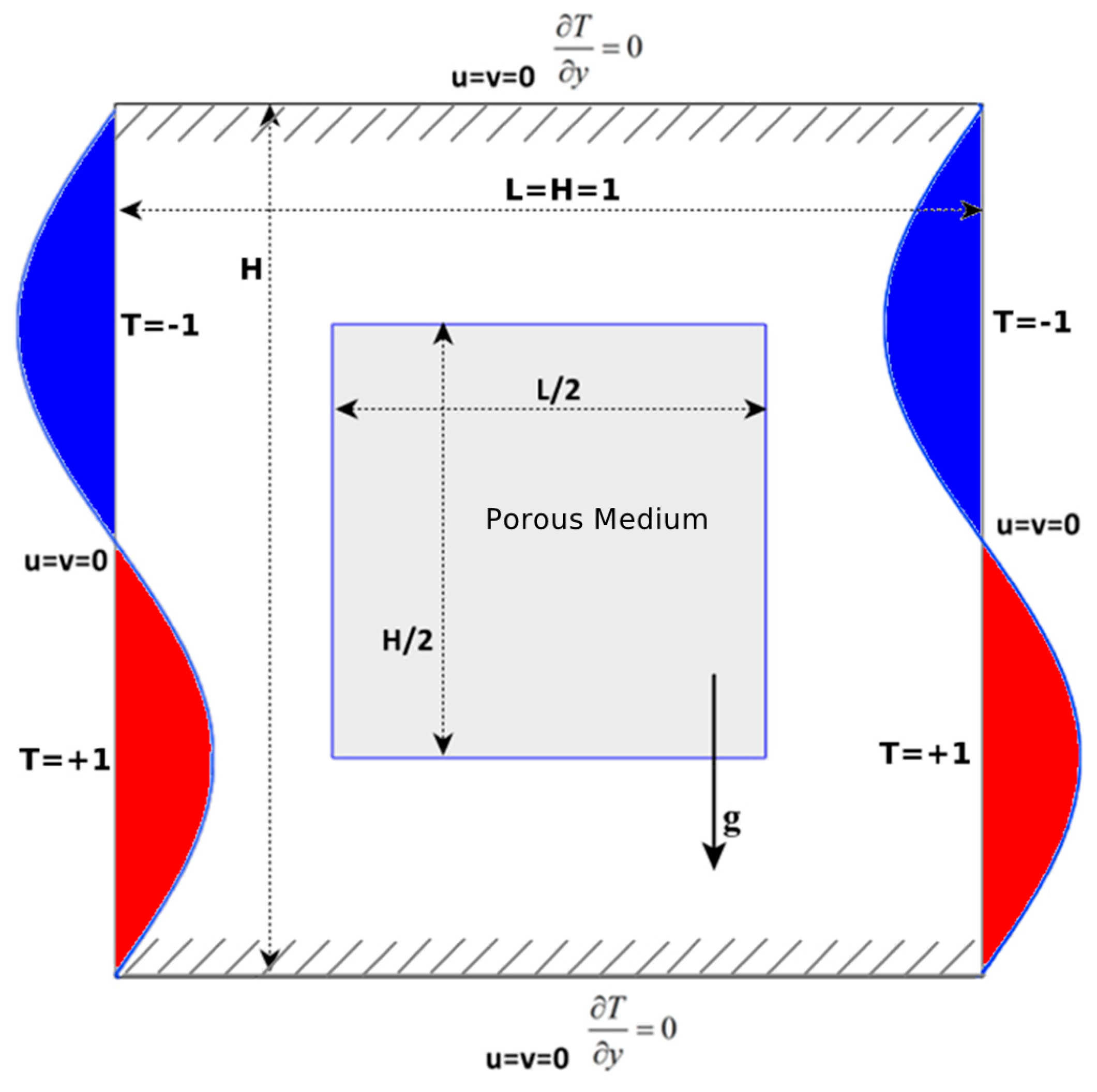
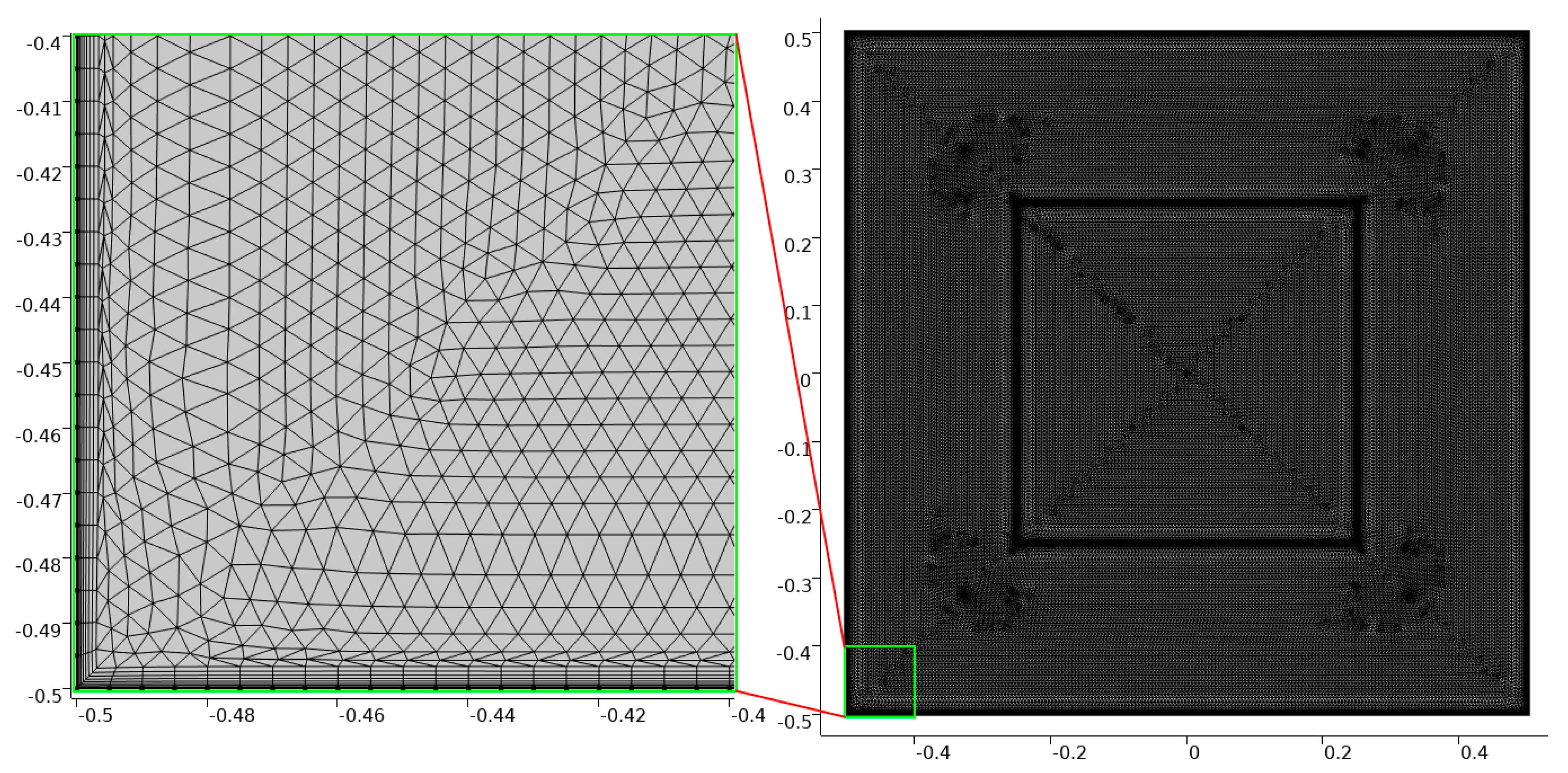
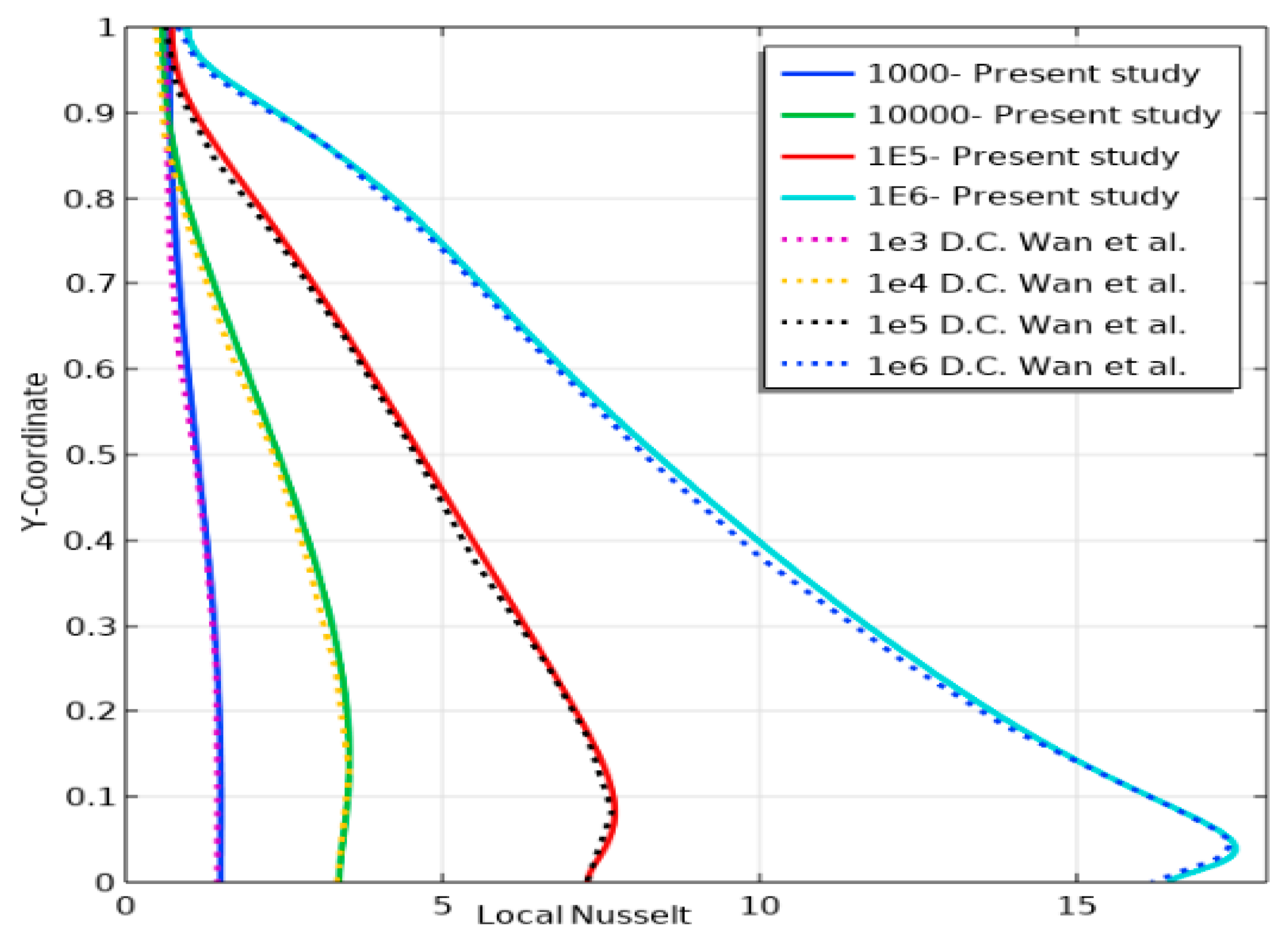
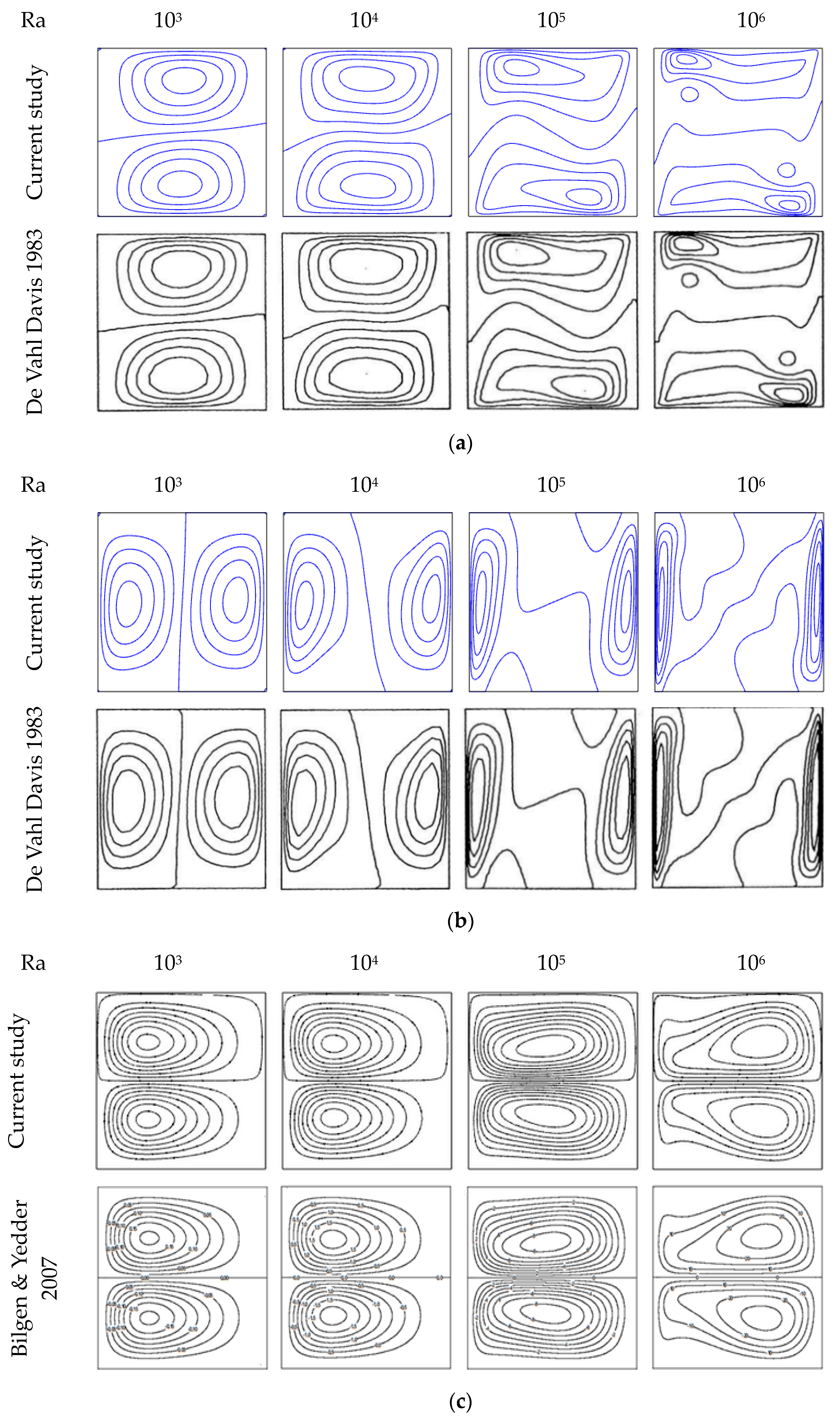

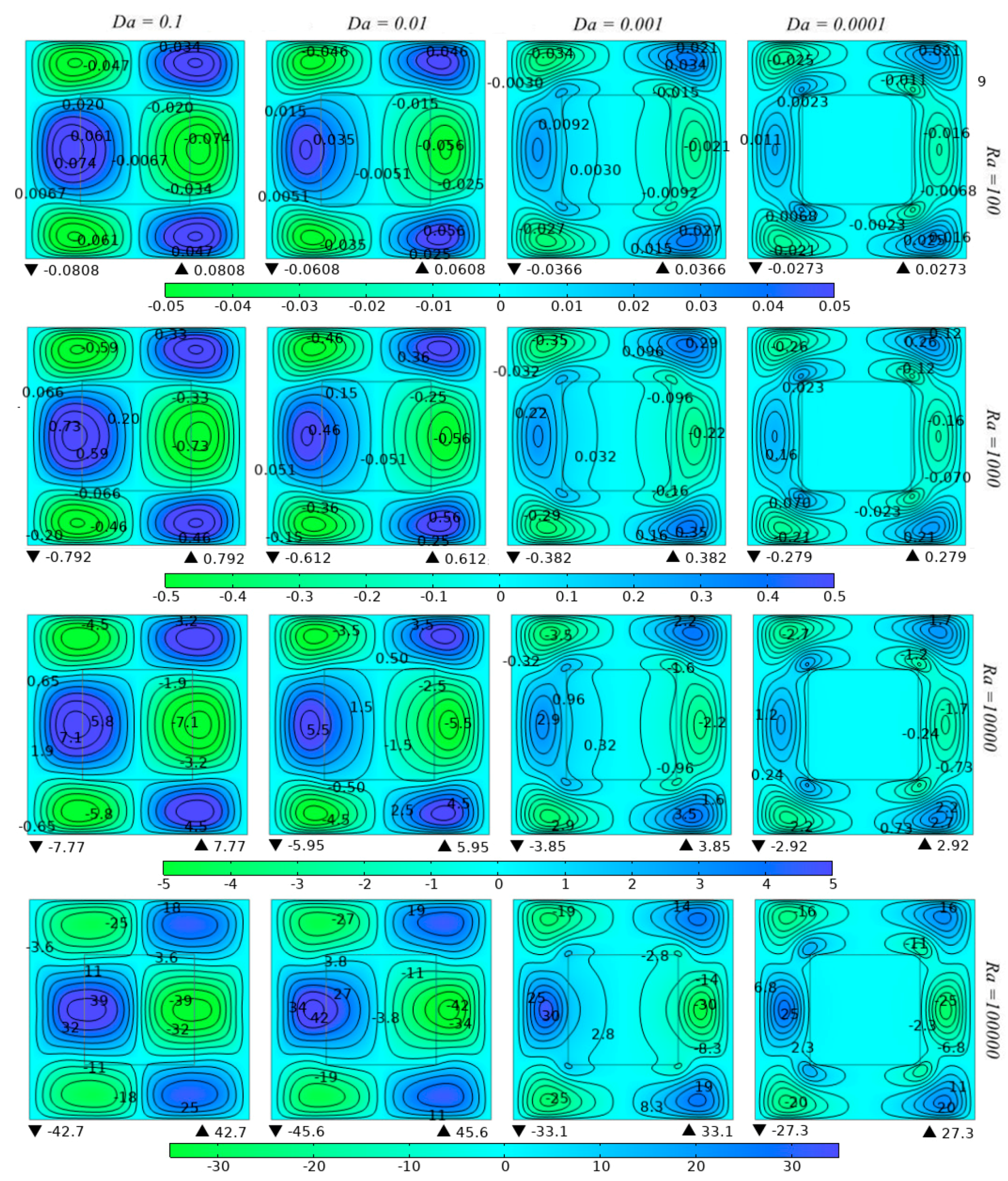
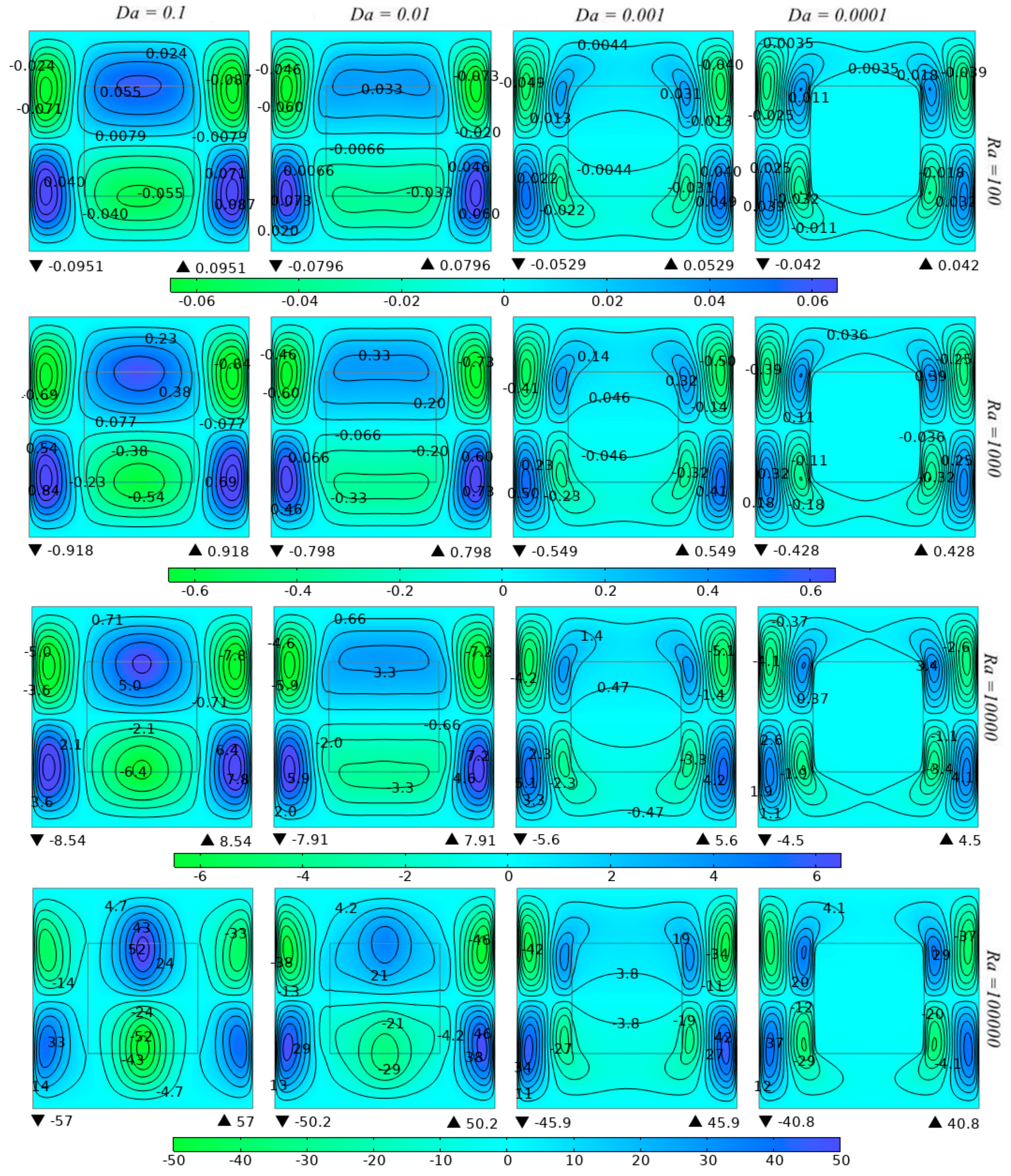


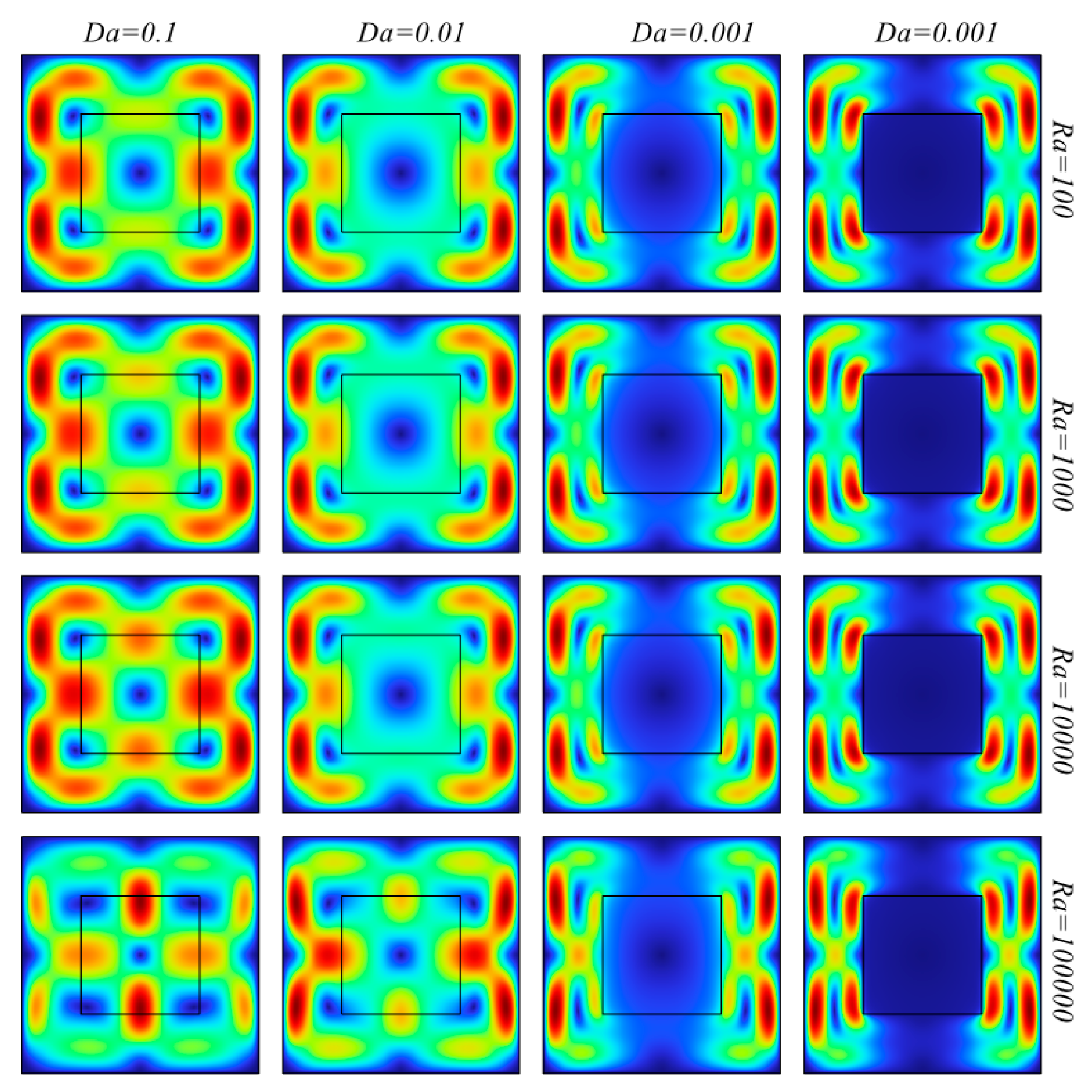

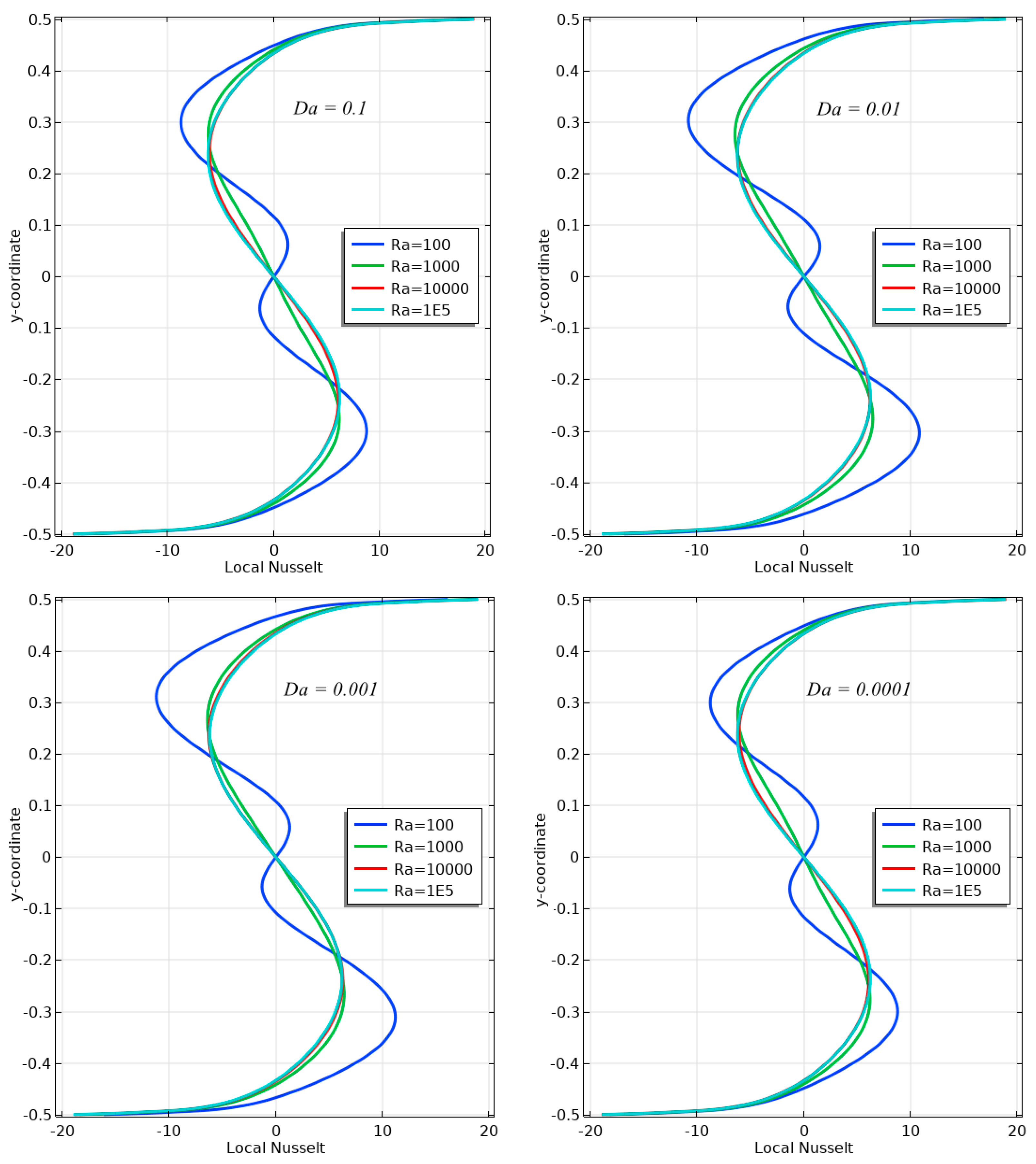
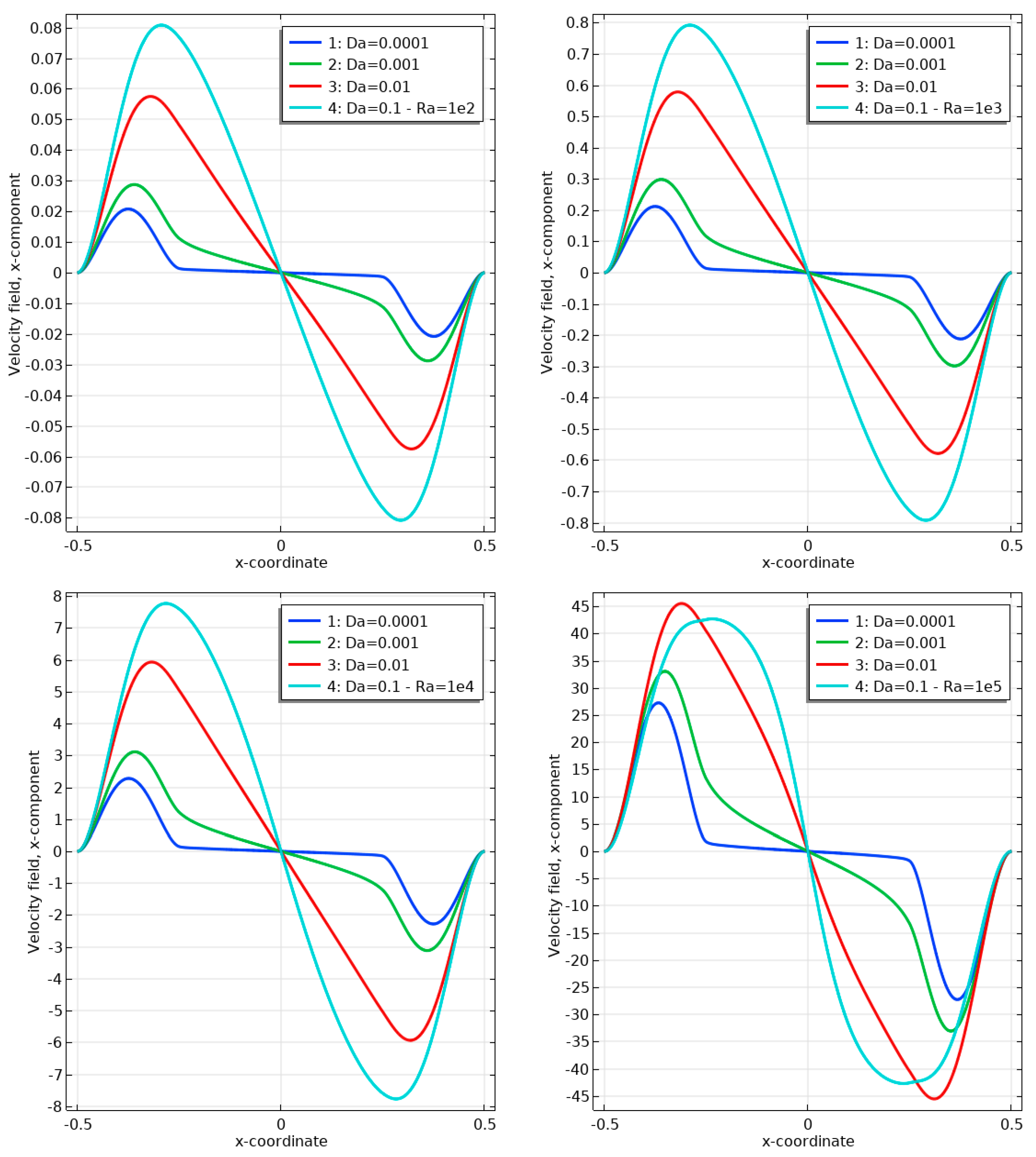

| Wan et al. [32] | De Vahl Davis [33] | Bilgen & Yedder [34] | This Study | |
|---|---|---|---|---|
| Ra | Nu | |||
| 103 | - | 1.117 | 1.117 | 1.1178 |
| 104 | 2.254 | 2.242 | 2.246 | 2.2442 |
| 105 | 4.598 | 4.531 | 4.532 | 4.5169 |
| 106 | 8.976 | 9.035 | 8.871 | 8.8073 |
| 107 | 16.656 | - | 16.845 | 16.399 |
| Ra | 103 | 104 | 105 | 106 | ||||
|---|---|---|---|---|---|---|---|---|
| Nu | De Vahl Davis [33] | Present Study | De Vahl Davis [33] | Present Simulation | De Vahl Davis [33] | Present Simulation | De Vahl Davis [33] | Present Simulation |
| 1.505 | 1.5063 | 3.528 | 3.5285 | 7.717 | 7.7047 | 17.925 | 17.455 | |
| 0.692 | 0.6912 | 0.586 | 0.5851 | 0.729 | 0.7282 | 0.989 | 0.9790 | |
| 1.117 | 1.1178 | 2.238 | 2.2442 | 4.509 | 4.5169 | 8.817 | 8.8073 | |
| 1.118 | 1.1317 | 2.243 | 2.4116 | 4.519 | 4.6553 | 8.799 | 8.3737 | |
Disclaimer/Publisher’s Note: The statements, opinions and data contained in all publications are solely those of the individual author(s) and contributor(s) and not of MDPI and/or the editor(s). MDPI and/or the editor(s) disclaim responsibility for any injury to people or property resulting from any ideas, methods, instructions or products referred to in the content. |
© 2024 by the authors. Licensee MDPI, Basel, Switzerland. This article is an open access article distributed under the terms and conditions of the Creative Commons Attribution (CC BY) license (https://creativecommons.org/licenses/by/4.0/).
Share and Cite
Farhat, B.; Kaid, N.; Alqahtani, S.; Menni, Y.; Alshammari, B.M.; Kolsi, L. Finite Element Analysis of Laminar Natural Convection in a Differentially Heated Porous Cavity Using the Darcy–Brinkman Model. Processes 2024, 12, 1974. https://doi.org/10.3390/pr12091974
Farhat B, Kaid N, Alqahtani S, Menni Y, Alshammari BM, Kolsi L. Finite Element Analysis of Laminar Natural Convection in a Differentially Heated Porous Cavity Using the Darcy–Brinkman Model. Processes. 2024; 12(9):1974. https://doi.org/10.3390/pr12091974
Chicago/Turabian StyleFarhat, Benabderrahmane, Noureddine Kaid, Sultan Alqahtani, Younes Menni, Badr M. Alshammari, and Lioua Kolsi. 2024. "Finite Element Analysis of Laminar Natural Convection in a Differentially Heated Porous Cavity Using the Darcy–Brinkman Model" Processes 12, no. 9: 1974. https://doi.org/10.3390/pr12091974









